Top News
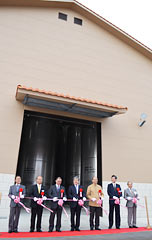
March 28, 2013 Ryukyu Shimpo
On March 27, the Township of Ryukyu Awamori-Sake, a cooperative consisting of 43 brewing companies, held the opening ceremony for an awamori storehouse at the International Logistics and Industry Accumulation Area in Uruma. The Ryukyu Kusu No Sato in Japanese has an administration building and a storage area. The cooperative moved unblended awamori from its breweries to the new facility and placed it in new storage area. Aged awamori kusu will be sold outside of Okinawa and used as a core product to expand the market and build the Ryukyu awamori brand.
The cooperative has set up ten 50-kiloliter tanks in one facility. They will construct five buildings in the next ten years, and set up a storage area to hold a total of 2500 kiloliters of kusu. The cooperative had collected 150 kiloliters from 15 brewery companies by March 27 and expects to have it all stored away in May and June.
Awamori needs to be stored for ten years, but shipment of kusu that has been stored for a minimum of five years will be considered depending on whether or not they need to move into the black within three years after completion of the facilities. The Kusu no Sato plans to build an awamori museum and to set up a bottling facility. In the administration building there will be a laboratory for researching changes in awamori components in order to maximize the added value of the product.
Board chairman Ryo Matsuda said, “This is a key project designed to boost the awamori industry over the next 10 to 30 years. With it being a core industry project for Okinawa, we really want to work together as a team to make it a success.”
(English translation by T&CT, Megumi Chibana and Mark Ealey)
Go to Japanese
March 30, 2013 Ryukyu Shimpo
The Okinawa Prefectural Assembly unanimously passed a resolution to protest against the Japanese government’s plan to hold a ceremony on April 28 to commemorate the anniversary of the restoration of Japanese sovereignty after the San Francisco Peace Treaty took effect in 1952. The municipal assemblies notably passed resolutions to protest against the holding of the ceremony.
When responding to a Ryukyu Shimpo questionnaire on the “Sovereignty restoration day,” about 80 percent of the 41 heads of the municipalities in Okinawa opposed the idea, with no one supporting it.
The people of Okinawa have employed democratic processes, and demand that the central government change its plan to hold the ceremony. The central government should pay particular attention to this fact. On that day in 1952, in exchange for the restoration of Japan’s sovereignty, Okinawa was separated from Japan and placed under U.S. occupation. All of the heads of the municipalities therefore see April 28, the date that the San Francisco Peace Treaty took effect in 1952, as a day of humiliation. It is therefore totally reasonable that none of the heads of the municipalities support a ceremony that celebrates this “Sovereignty restoration day.”
We would like to ask Prime Minister Shinzo Abe if he still intends to hold this ceremony despite knowing the results of this questionnaire.
If the central government goes ahead with it, in effect it is publicly admitting that it blatantly discriminates against Okinawa. The central government should place priority on verifying just what Japanese sovereignty actually represents before holding the ceremony.
If Japan is indeed a true democratic country, and is prepared to listen to Okinawa’s voice, the government should cancel this event. Abe claims that holding the ceremony will serve to commemorate the 60th anniversary of Japan’s return to the international community, but we wonder if Japan is confident that its sovereignty has really been restored despite its ongoing diplomatic subservience to the United States, let alone the inequalities of the U.S.-Japan Status of Forces Agreement. Japanese government internal communication calls for Diet lawmakers to attend the ceremony, referring to, “the complete restoration of our nations’ sovereignty.” It does not mention the fact that on that day Okinawa was separated from Japan along with the Amami Islands in Kagoshima Prefecture and the Ogasawara Islands and placed under U.S. occupation, and that Japan’s sovereignty is still anything but complete. This is extremely difficult to fathom.
Abe and Chief Cabinet Secretary Minister Yoshihide Suga have repeatedly asserted that Japan should not forget Okinawa’s history of suffering. We would like to ask what these statements actually mean. When all is said and done, have they lied about respecting Okinawa? We would like those in the central government to imagine how the Okinawan people are disappointed and angry at the Japanese government’s irresponsible attitude, that is once again demonstrated here.
In the Ryukyu Shimpo questionnaire, more than 60 percent of the heads of the municipalities in Okinawa said that Okinawan Governor Hirokazu Nakaima should not attend the ceremony. It is safe to say that many heads agreed with Nakaima, who from the very start has criticized the central government’s plan to hold the ceremony by saying it is entirely incomprehensible. As an act of protest, Nakaima should firmly announce his intention not to appear in the ceremony.
(English translation by T&CT, Mark Ealey)
Go to Japanese
March 30, 2013 Ryukyu Shimpo
In the plenary session of its regular meeting on March 29, the Okinawa Prefectural Assembly unanimously passed a resolution to protest against the Japanese government planning to hold a ceremony on April 28 to commemorate the anniversary of the restoration of Japanese sovereignty after the San Francisco Peace Treaty took effect in 1952. Assembly members affiliated to the Liberal Democratic Party (LDP) walked out. The resolution states, “Okinawa was separated from Japan that day. We see it as nothing less than a day of humiliation.” It went on to state, “We strongly oppose the central government holding this ceremony, and protest against it.”
The members of the ruling LDP and the Komei Party reacted differently to the issue. The assembly accepted the resolution proposed by members of opposition parties and the Komei Party, which created an unusual situation.
The resolution mentioned the fact that U.S. military bases in Japan are still concentrated on Okinawa after its reversion to Japanese sovereignty. It said, “Okinawan people are still suffering from crimes and incidents involving U.S. military personnel, and noise generated by aircraft flying from the bases.
Furthermore, the Japanese government has deployed the Osprey to Okinawa, and is on its way to constructing an alternative facility for the relocation of Futenma Air Station to Henoko, overriding resistance from Okinawa in the process.” The resolution asserted that “what the central government should do first is ease Okinawa’s burden for hosting U.S. bases.”
In that context, the resolution strongly criticized the Japanese government, saying, “To hold the ceremony is to trample over Okinawan people’s feelings, and to cut Okinawa adrift for a second time. It is unforgivable.”
With regard to the resolution to protest against the April 28 ceremony, while on the one hand members of the LDP appeared reluctant to accept the title of a resolution that included the word “protest,” and the expression “oppose the ceremony.” On the other hand, the Reformation Association asserted that the resolution should include the words “Halt the ceremony.” Parliamentary groups and members of the LDP negotiated for several days in a row, but in the end they could not reach an agreement. In the plenary session, opposition parties proposed the resolution in protest against the ceremony, whilst the members of the LDP proposed their own resolution.
Following this, the members moved quickly to hold a meeting of the General Coordination and Policy Planning Committee to vote on the resolution. The assembly unanimously accepted the resolution proposed by the opposition parties, but in the plenary session held after that, the members of the LDP decided to walk out. The remaining assembly members then unanimously passed the resolution to protest against the ceremony.
(English translation by T&CT, Mark Ealey)
Go to Japanese

March 29, 2013 Ryukyu Shimpo
The Okinawa Prefectural Government (OPG) hopes to increase the number of foreign tourists visiting Okinawa from the current level of 380000 per year to about two million by 2021. As a step in that direction, on March 28 at a press conference held at the Naha Terrace Hotel, the OPG unveiled a new promotion campaign entitled “Be. Okinawa.” As its core image, in order to express the gentle nature and passage of time in Okinawa the OPG created a logo featuring the prefecture’s main island in a hibiscus floral motif. They are attempting to sell a new image of Okinawa to customers in overseas markets using media such as websites, posters and flyers.
In his speech, Okinawa Governor Hirokazu Nakaima said, “We want tourism to be a major industry and want to attract tourists using a range of methods. With your support, we will let people overseas know about the new Okinawa tourism brand.”
The OPG decided upon the new Okinawa brand for the overseas market after discussion in a review meeting. They looked into tourism trends concerning Okinawa as a travel destination, surveying about 7000 people in 15 countries and 17 regions in Southeast Asia, Europe, and North America. The report focused on what attracts tourists in each region to Okinawa. The survey indicates that Europeans are particularly attracted by things such as the prefecture’s “beautiful scenery and peace and quiet,” as well as “the opportunity to meet all sorts of people.”
Okinawa already attracts many foreign tourists from Taiwan, Korea, China and Hong Kong, but relatively few from North America and Europe. The survey results indicated that the OPG should launch a campaign using new branding for its tourism industry.
(English translation by T&CT, Mark Ealey)
Go to Japanese
March 28, 2013 Ryukyu Shimpo
At 10:15am on March 27, Naha Airport temporarily stopped operations because a pair of scissors (10 centimeter long blade) was found in a boarding bridge connecting the building and an aircraft. For security reasons the airport office closed the access way to the inspection area. They checked the inside of the aircraft and the security area of the airport by having passengers vacate the area.
As a result, eight flights arriving or departing from the airport were canceled, and about 120 flights were delayed by as much as four hours. It is thought that this incident may have affected more than 20000 passengers.
The pair of scissors was found in what is a restricted “clean” area for dangerous goods such as explosives and things with blades. According to the airport authorities, a female passenger on Jetstar flight 133, which arrived from Narita at 9:43am, dropped the scissors from her bag when she was walking through the boarding bridge. A Jetstar staff member picked the scissors up and returned them to her.
The airport authorities evacuated all passengers who were in the security area after receiving notification from Jetstar. Considering that other passengers may have also brought scissors on board they re-examined all the baggage. Two safety inspection areas were closed for about 90 minutes. Officials have looked for the woman, but are yet to find her.
(English translation by T&CT, Mark Ealey)
Go to Japanese
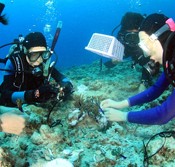
March 24, 2013 Hideaki Yoneda of the Ryukyu Shimpo
On March 4 and 5, the Tokashiki Scuba Diving Association started a campaign to preserve a coral reef. They have transplanted coral after cleaning up an area of coast and removing acanthaster starfish, the main natural enemy of reef-building coral.
A total of 70 people took part, including 47 members of 16 dive shops on the island and 23 volunteers from the NPO Churaumi Council. They planted 207 seedlings in the coastal area of Tokashiku.
Haruhiro Kuniyoshi, a member of the association, said, “We want to do this every year in an attempt to attract tourists during the winter season and to let people know about the current state of the sea around Tokashiki.” He added, “Working with the Zamami Municipal Office, we want this to develop into a major event in Japan.”
(English translation by T&CT, Mark Ealey)
Go to Japanese
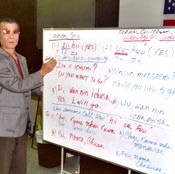
March 25, 2013 Sadao Tome Correspondent of Ryukyu Shimpo
Ten years have passed since 72 year-old Chogi Higa established a class teaching Uchinaguchi or the Okinawan language in a room in the Okinawa Association of Los Angeles building in Gardena. On February 25, Los Angeles Times reporter Cindy Chang wrote a story entitled Keeping the Okinawan Language Alive. Chang participated in the class twice before writing the article.
Before the class, the students repeat expressions such as ukimisochi or “good morning” and uganjuyamisemi or “how are you?” About 40 students, ranging from teenagers to 80 year-olds, attend the class, which is held twice a month. Tokie Koyama said, “Attending the class reminds me of my childhood in Okinawa. It brings tears to my eyes.” Higa teaches Okinawan terms such as nihedebil or “thank you” and guburisabira or “excuse me” by translating them into English or Japanese. The students are members of the association.
Joan Oshiro, a 68 year-old second-generation Okinawan Hawaiian, who is fluent in Japanese, said, “The class makes me realize that being Okinawan is clearly different from other Japanese even though I am proud of being American citizen.”
Shoichi Iwasaki, a professor in the Department of Asian Languages and Cultures at University of California, Los Angeles who works on a collaborative project called the Ikema Project – an attempt to preserve an endangered language of Ryukyu Islands – said, “The language of Ikema Island, which is located to the northwest of Miyako Island in Okinawa, will possibly die out before too long. As has been the case with Ancient French, I think that Uchinaguchi – the language of main islands of Okinawa – will survive in the form of nursery songs for quite some time yet.”
Iwasaki went on to say, “I appreciate Higa’s passion for preserving and maintaining Uchinaguchi, but there is a limit to what he can do. He now needs to foster younger people to carry on his good work.”
(English translation by T&CT, Mark Ealey)
Go to Japanese
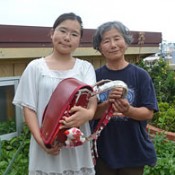
March 25, 2013 Tsubaki Mekaru of the Ryukyu Shimpo
On March 21, Yuki Shimabukuro graduated from Kitami Elementary School in Okinawa City. The school bag that she had with her that day had previously been used by her sister Haruka, and between them it had carried school books for a total of 12 years. Every time the bag needed to be repaired, her grandmother Rei Takao would fix it. “Thank you for the last 12 years,” Yuki said to the bag and to her grandmother. The Shimabukuro sisters have always been close. When Haruka was in the upper grades at school, Yuki wanted to use her school bag, so Haruka looked after it well.
By the time that Yuki entered the fourth grade, the edge of the cover of the bag was a little tattered and a shoulder strap was broken, but Yuki said, “My grandma fixed it straightaway.” Her grandmother said, “Stitching the leather was hard work.”
Sometimes her friends made fun of her because she had a patched up satchel, but she just explained to them that it was something precious that she had received from her older sister, and kept on using it. Yuki said recently people commented that her using something old was a good thing to do.
With Yuki graduating from elementary school, the bag will go into retirement. Her grandmother said, “This experience may have given Yuki an appreciation of the value of old things.” Haruka, who is now studying at outside Okinawa, and has her eyes set on going on to study at university, sent a message to Yuki stating “I’m really glad that you’ve looked after the satchel.”
“Every time I used the bag, I somehow felt that I was together with my sister. Thanks to my grandmother’s help I was able to use the bag for six years. I’m grateful to everyone.”
(English translation by T&CT, Lima Tokumori and Mark Ealey)
Go to Japanese
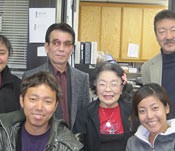
March 18, 2013 Sadao Tome, correspondent of Ryukyu Shimpo
The Kin Municipal Office invited descendants of migrants from Kin Town as an internship program for them since 17 years ago. Three years ago, the municipal office began to send interns from the Kin community to locations abroad. On February 8, members of the Youth Overseas Dispatch Program Muneaki Gakiya and Tomoyo Ajifu visited the Okinawa Association of America. They have finished an internship experience of nine days in Brazil, five days in Argentine, nine days in Bolivia, four days in Peru and in Los Angeles.
Their goal is to interact with descendants of migrants living in foreign countries. Upon their return to Okinawa, they will give a report about their experience at a meeting attended by members of the Youth Association and the Commerce and Industry Association. In Los Angeles, they observed a soilless farming facility owned by Kanji Yasutomi, met with members of the Okinawa Association of America, and visited the Japanese American National Museum to learn about the history of Japanese immigrants.
(English translation by T&CT, Hitomi Shinzato and Mark Ealey)
Go to Japanese
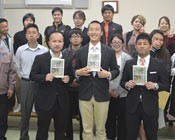
March 14, 2013 Ryukyu Shimpo
The Ginowan Youth Eisa History Committee has published a book on eisa dance as performed in Ginowan. The book also covers the history of eisa in the local community, and took about five years to prepare. Using interviews and various documentary records they researched eisa’s origin, as well as the dances, songs and clothes used in each area. The book deals with the eisa of Ginowan from before World War II through to the modern day.
According to the committee, eisa dances have existed in many of the districts of Ginowan since the Meiji Period, although entertainment, including eisa, was prohibited during the Battle of Okinawa. After the war, residents of 18 areas restored their eisa or created them afresh. In some communities traditional events were lost, but today people continue to hold eisa events in the 18 areas.
Early in the postwar period, because of the shortage of materials many people used to beat U.S. military water tanks instead of drums. The book shows how residents developed eisa as they re-established their communities. Through interviews, the book also tells the story of eisa in the Isahama, Aniya and Nakahara communities, where the U.S. military took land from the local people.
Head of the committee, Iwaro Nakamoto, became interested in eisa when he came to Okinawa to go to university. In the past, he has also served as the president of the Nagata Youth Association in Ginowan. “I’ll be happy if this book helps people understand of the origin of their community’s eisa and promotes community life and eisa through talking about stories from years gone by,” he said.
They have printed 400 copies and will send them to youth associations, community associations and people who have cooperated in the initiative. For further details, call the Ginowan Youth Association, at 098 (893) 4431.
(English translation by T&CT, Lima Tokumori and Mark Ealey)
Go to Japanese

March 23, 2013 Ryukyu Shimpo
On the morning of March 22, the male tiger called Shima was found dead in the Okinawa Kodomo no Kuni, Zoo & Museum in Okinawa City. Shima was 19 years old, which in human terms is the equivalent of a 90 year-old.
A spokesperson for the zoo said that the tiger died of natural causes. According to zoo staff, Shima had been sick for about a month, and had not eaten for the past week. Keepers waited for Shima’s appetite to recover and made changes to the food that they provided, but he still did not eat it. So in the end, a keeper found Shima dead at around 8:00am on March 22.
Shima was born in May 1993 and came to Okinawa from the Tobe Zoo in Ehime Prefecture in September 1995. The only tiger in the zoo, he has been popular among children, but last year he became increasing ill as he grew old.
Genwa Higa, the director of the zoo, said, “Shima was able to live out his natural life span, but we really did want to celebrate his twentieth birthday.” The zoo will create a skeletal representation of the tiger.
(English translation by T&CT, Mark Ealey)
Go to Japanese








 Webcam(Kokusai Street)
Webcam(Kokusai Street)


